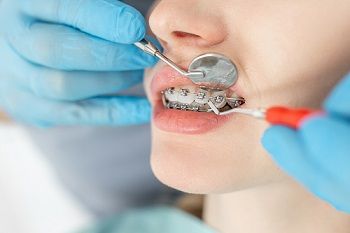How to Choose the Right Orthodontic Treatment for Your Needs?
A confident smile can transform not only your appearance but also your self-esteem. If you're considering orthodontic treatment to address dental issues like crooked teeth, misalignment, or bite problems, you're on the right path to achieving a beautiful and healthy smile. However, with various treatment options available, choosing the proper orthodontic treatment can be overwhelming. This blog guides you through selecting the ideal orthodontic treatment that suits your needs.
Consulting with an Orthodontist
Consulting with an orthodontist is crucial for choosing the right treatment. They can assess your unique dental situation and provide personalized recommendations.
- Importance of Professional Evaluation: Orthodontists undergo extensive education and training in dentistry, specializing in orthodontics. Their in-depth knowledge and experience enable them to diagnose orthodontic issues accurately and create customized treatment plans. By consulting with an orthodontist, you benefit from their expertise and receive an accurate assessment of your dental condition.
- Initial Consultation: Schedule an initial consultation with an orthodontist for a comprehensive exam of your teeth, jaws, and facial structure. This evaluation helps them identify underlying problems and determine the best treatment options.
- Discussing Treatment Options: The orthodontist will discuss treatment options and explain their advantages and limitations. This helps you decide which approach aligns best with your goals.
- Addressing Concerns and Questions: Consult an orthodontist to get clear answers to your questions and concerns about treatment duration, discomfort, and aesthetics. They will provide a comprehensive understanding of the recommended treatment plan.
- Customized Treatment Plan: After evaluating your needs and preferences, the orthodontist will create a personalized treatment plan outlining the best method and timeline. This gives you confidence in your orthodontic treatment.
- Ongoing Monitoring and Follow-up: Regular check-ups with the orthodontist keep your treatment on track, making adjustments and catching issues early for the best results.
Choosing a qualified orthodontist is essential. Get recommendations from your dentist, friends, or family and ask about their credentials. Consulting with an orthodontist will help you choose the right treatment for a healthy, beautiful smile.

Considering Lifestyle Factors
When selecting the right orthodontic treatment for your needs, it's important to consider various lifestyle factors that can influence your treatment experience. Orthodontic treatments can impact your daily life, so considering these factors will help ensure your chosen treatment aligns well with your lifestyle. Here are some key lifestyle factors to consider:
- Appearance and Confidence: The visibility of orthodontic appliances can concern many individuals. Traditional metal braces may be more noticeable, while options like clear aligners or lingual braces are more discreet. Consider your comfort level with the visibility of the treatment and how it may affect your confidence in social and professional settings.
- Treatment Duration: Orthodontic treatments can vary from several months to a few years. Consider the time commitment required for each treatment option and how it fits into your lifestyle. Some treatments, like accelerated orthodontics, offer faster results but may involve more frequent appointments. Balancing treatment duration with your schedule is crucial.
- Dietary Restrictions: Certain orthodontic treatments, such as traditional braces, may require dietary adjustments. Sticky or hard foods can pose challenges and must be avoided to prevent appliance damage. On the other hand, clear aligners are removable, allowing you to enjoy your favorite foods with fewer restrictions. Consider how dietary modifications impact your lifestyle and choose a treatment that aligns with your preferences.
- Oral Hygiene: Proper oral hygiene is essential during orthodontic treatment to prevent tooth decay or gum disease. Some treatment options, such as braces, require extra attention to ensure proper cleaning around the appliances. Clear aligners, which can be removed for brushing and flossing, offer more convenience in maintaining oral hygiene. Assess your commitment to oral care and choose a treatment option that fits your ability to maintain good oral hygiene habits.
- Sports and Physical Activities: If you're an athlete or engage in regular physical activities, you'll want to consider the impact of orthodontic treatment on your performance and safety. Traditional braces may require additional protective measures, such as mouthguards, to prevent injuries during contact sports. Discuss your lifestyle and sports involvement with your orthodontist to determine the best treatment approach.
- Professional Considerations: Some professions may have specific requirements or expectations regarding appearance. If you work in a customer-facing role or have specific appearance standards to meet, consider how different orthodontic treatments may impact your professional image. Opting for more discreet treatment options might be beneficial in these cases.
By carefully considering these lifestyle factors, you can choose an orthodontic treatment that fits seamlessly into your daily routine and supports your desired lifestyle. Remember to discuss your preferences and concerns with your orthodontist, as they can provide valuable insights and recommendations based on your unique circumstances.

Cost and Insurance Coverage
Understanding the cost involved and exploring insurance coverage options are essential when considering orthodontic treatment. Orthodontic treatment costs can vary depending on factors such as the type of treatment, the complexity of the case, and the geographical location. Here's what you need to know about the cost of orthodontic treatment and potential insurance coverage:
- Cost of Orthodontic Treatment: The cost of orthodontic treatment can include several components. These may include the initial consultation, diagnostic tests (such as X-rays or scans), orthodontic appliances (braces, aligners, retainers), adjustment appointments, and any additional procedures or treatments required. It's important to comprehensively understand the overall cost before proceeding with treatment.
- Obtaining a Treatment Estimate: During your initial consultation, your orthodontist will estimate the anticipated costs. This estimate will vary based on the complexity of your case, the chosen treatment method, and the expected duration of treatment. Ask any questions regarding the breakdown of costs to ensure a clear understanding.
- Insurance Coverage: Dental insurance plans may cover orthodontic treatment, but reviewing your specific plan details is important. Not all insurance plans cover orthodontic treatment, and those that do often have limitations and restrictions. Contact your insurance provider or review your policy to understand the extent of coverage for orthodontics. Be aware of waiting periods, maximum coverage amounts, and required pre-authorization or documentation.
Remember to have an open discussion with your orthodontist about your financial concerns and goals. They can guide available payment options, insurance coverage, and potential financing plans. By understanding the cost and exploring insurance coverage, you can plan for the financial aspects of your orthodontic treatment and make a decision that suits your budget and overall needs.
Considering Personal Preferences
Regarding orthodontic treatment, personal preferences play a significant role in ensuring a positive and satisfying experience. Considering your preferences allows you to choose a treatment option that aligns with your goals, lifestyle, and comfort. Here are some key aspects of personal preferences to consider:
- Treatment Visibility: The visibility of orthodontic appliances can be an important consideration for many individuals. Traditional metal braces are easily noticeable, while options like ceramic braces or clear aligners are more discreet. Think about how comfortable you are with the visibility of the treatment and how it may affect your confidence and social interactions.
- Aesthetics: Beyond visibility, consider the overall aesthetics of the treatment. Some treatments offer tooth-colored brackets or aligners that blend with natural teeth, providing a more subtle appearance. If maintaining a natural-looking smile is important, discuss aesthetic options with your orthodontist.
- Treatment Timeframe: Orthodontic treatments can vary in duration, ranging from a few months to several years. Consider your patience and commitment level when it comes to the duration of the treatment. If you prefer a shorter treatment duration, options like accelerated orthodontics or short-term braces may suit you.
- Comfort: Orthodontic treatments can sometimes cause discomfort or soreness, especially during adjustment periods. Traditional braces may require adjustments and can cause mild discomfort. Clear aligners, on the other hand, are generally more comfortable as they don't involve wires or brackets. Reflect on your sensitivity to discomfort and choose a treatment option that suits your comfort level.
By considering these personal preferences, you can make an informed decision about the right orthodontic treatment for your needs. Discuss your preferences with your Orthodontist in Danville, as they can provide insights and recommendations based on your circumstances. Choosing a treatment option that aligns with your preferences will provide a more positive and satisfying orthodontic experience.
Contact your Danville dentist, Dr. Hoss Abar, DDS, MSD, at Danville Orthodontics to learn more about How to Choose the Right Orthodontic Treatment for Your Needs.
Resource:
How Do Orthodontic Treatments Work?
*Neither this nor any other content in this media is meant to prescribe, recommend, or prevent any treatment or procedure. We highly recommend that you get the advice of a qualified dentist or other medical practitioners regarding your specific dental condition.
